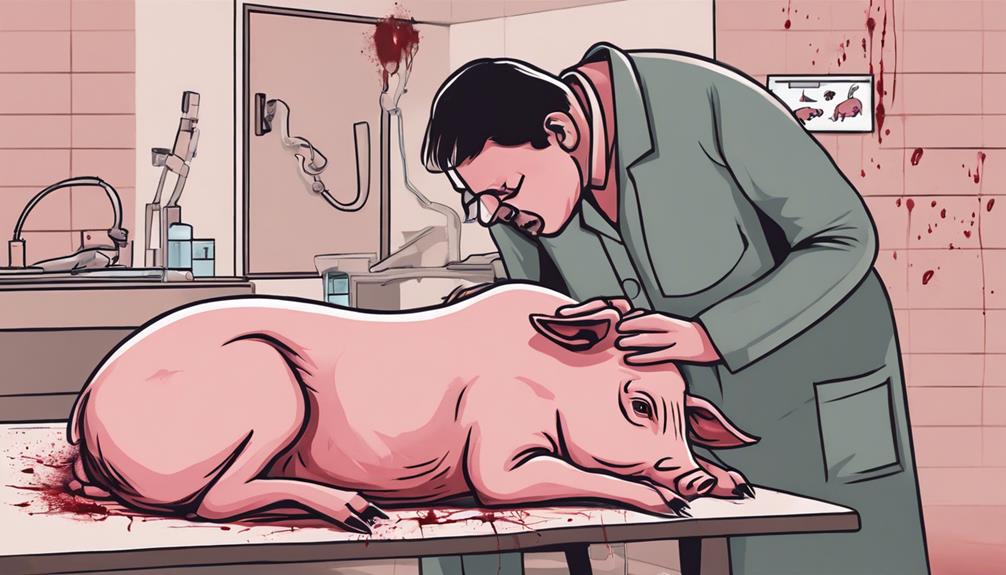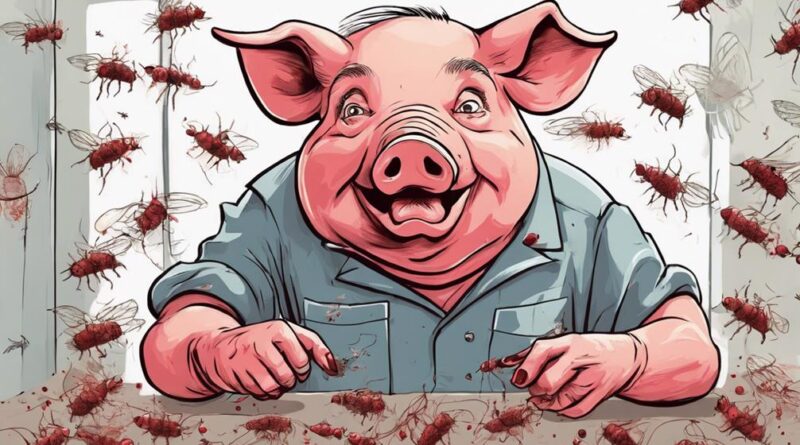8 Key Signs of Zoonotic Diseases in Pigs
So, you think pigs are just cute and oink all day? Think again. When it comes to zoonotic diseases, these farm animals can be more than meets the eye.
From subtle behavioral changes to more alarming signs, understanding what to look out for is crucial.
Stay aware of these eight key indicators that could signal a potential risk not only for the pigs but for you as well.
Let's explore the telltale signs that might be right under your snout.
Behavioral Changes
If you notice your pigs exhibiting unusual behaviors, such as increased aggression or lethargy, it could indicate signs of zoonotic diseases. Behavioral changes in pigs are essential stress indicators that shouldn't be overlooked. Pigs are social animals, so any sudden aggression towards penmates or handlers can be a red flag. On the other hand, if your pigs are unusually lethargic and disinterested in their surroundings, it could also be a cause for concern.
Stress indicators like these behavioral changes can signal underlying health issues that may affect both your pigs and potentially you. Zoonotic diseases are infections that can be transmitted from animals to humans, making it crucial to address any concerning behaviors promptly. By paying close attention to how your pigs interact with each other and their environment, you can catch potential zoonotic diseases early on.
Keep an eye out for any other abnormal behaviors such as excessive scratching, restlessness, or changes in eating habits. These signs, when coupled with behavioral changes like aggression or lethargy, can provide valuable insight into the health of your pigs. Remember, early detection and intervention are key in managing zoonotic diseases and ensuring the well-being of both your pigs and yourself.
Respiratory Symptoms
Respiratory symptoms in pigs can manifest as coughing, sneezing, or difficulty breathing, indicating potential zoonotic diseases that require prompt attention.
- Breathing Difficulties: Notice if your pigs are struggling to breathe or are breathing rapidly. Labored breathing can signal respiratory distress.
- Coughing: Keep an ear out for persistent coughing in your pigs. Coughing can be a sign of respiratory infections or other illnesses.
- Nasal Discharge: Check for any abnormal discharge from the pig's nose. Discolored or excessive nasal discharge can be a red flag for respiratory issues.
- Sneezing: While occasional sneezing is normal, frequent or violent sneezing could indicate an underlying problem. Monitor your pigs for sneezing episodes.
- Wheezing: Listen for any wheezing sounds when your pigs breathe. Wheezing is often associated with respiratory problems and should be investigated promptly.
Being vigilant about these respiratory symptoms is crucial in detecting and addressing potential zoonotic diseases in pigs. If you observe any of these signs, consult a veterinarian for a thorough evaluation and appropriate treatment.
Skin Lesions
Skin lesions in pigs can serve as important indicators of potential zoonotic diseases that necessitate prompt attention. Identifying these lesions accurately is crucial for timely intervention. Lesions can manifest in various forms such as ulcers, scabs, or raised bumps on the skin. When observing these abnormalities, it's essential to consider the possibility of zoonotic diseases that can be transmitted to humans.
To effectively address skin lesions in pigs, proper identification is key. Lesions caused by zoonotic diseases may exhibit distinct characteristics that differentiate them from common skin issues. Seek veterinary assistance to accurately diagnose the lesions and determine the appropriate course of action.
Treatment options for skin lesions in pigs vary depending on the underlying cause. Zoonotic diseases may require specific medications to treat both the pig and prevent transmission to humans. Additionally, implementing biosecurity measures is crucial to prevent further spread of the disease within the herd and to individuals in contact with the infected animals.
Digestive Issues
When addressing digestive issues in pigs, careful monitoring of their eating habits and stool consistency is essential. Digestive problems can indicate underlying health issues that need prompt attention.
Here are some key points to consider:
- Observe Eating Habits: Keep an eye on your pigs' eating patterns. A sudden decrease or increase in appetite could signal a problem.
- Check Stool Consistency: Healthy stools are well-formed and consistent. Diarrhea or constipation may indicate digestive issues.
- Maintain Proper Hygiene: Ensure clean living conditions to prevent the spread of diseases that can affect the digestive system.
- Implement Dietary Management: Provide a balanced diet rich in nutrients to support digestive health and overall well-being.
- Routine Parasite Control: Regularly deworm your pigs and monitor for signs of parasitic infections, which can impact their digestion.
Neurological Signs
To further understand the health of your pigs, it's important to recognize neurological signs that may indicate potential zoonotic diseases. When observing your pigs, be vigilant for any seizure patterns or movement abnormalities. Seizure patterns can manifest as sudden, uncontrolled movements or convulsions, while movement abnormalities may present as difficulty walking, tremors, or paralysis. These signs could be indicative of zoonotic diseases that affect the neurological system.
Another crucial aspect to watch for is cognitive dysfunction and altered consciousness in your pigs. Cognitive dysfunction may be observed through disorientation, confusion, or changes in behavior. Altered consciousness can range from lethargy and stupor to more severe symptoms like coma. These signs suggest potential neurological involvement that could be linked to zoonotic diseases.
If you notice any of these neurological signs in your pigs, it's essential to promptly consult with a veterinarian for a thorough evaluation and appropriate testing. Early detection and intervention are key in managing zoonotic diseases that affect the neurological health of your pigs. By staying attentive to these neurological signs, you can help safeguard both the well-being of your pigs and potentially your own health.
Fever and Lethargy
If your pigs are displaying signs of fever and lethargy, it's crucial to take immediate action and monitor their condition closely. Fever, indicated by an elevated body temperature, and lethargy, characterized by a lack of energy and interest in usual activities, can be key indicators of underlying health issues in pigs.
Here's what you need to consider:
- Temperature abnormalities: Monitor your pig's body temperature regularly using a thermometer to track any fluctuations. Fever could point towards an infection or inflammatory process that needs veterinary attention.
- Energy levels: Keep an eye on your pig's activity levels and behavior. A decrease in energy, reluctance to move, or lack of interest in food or water could signal an underlying problem.
- Body temperature fluctuations: While fever is a common sign of illness, be aware of any sudden drops in body temperature as well. Hypothermia can also be a serious concern and may require immediate intervention.
- Veterinary consultation: If you notice persistent fever and lethargy, consult a veterinarian promptly for a thorough examination and proper diagnosis.
- Isolation: Consider isolating the affected pig to prevent the potential spread of any infectious diseases to other animals in the herd until a diagnosis is made.
Reproductive Problems

Reproductive problems in pigs can significantly impact breeding success and overall herd health. When dealing with fertility issues, it's crucial to address them promptly to maintain a productive herd. Pigs may experience fertility issues due to various factors, including age, genetics, nutrition, and environmental stressors. Monitoring the reproductive health of your pigs is essential to identify and address any problems early on.
Hormonal imbalances can also contribute to reproductive problems in pigs. These imbalances can disrupt the estrous cycle in females and decrease sperm production in males, leading to difficulties in breeding. Keeping a close eye on the signs of hormonal imbalances, such as irregular heat cycles, decreased libido, or abnormal estrus behavior, can help you detect issues before they escalate.
To manage reproductive problems effectively, work closely with a veterinarian to develop a comprehensive reproductive health program for your pigs. This program may include regular health checks, nutritional adjustments, and hormone therapy if necessary. By staying proactive and addressing fertility issues and hormonal imbalances promptly, you can help ensure a successful breeding program and maintain the overall health and productivity of your pig herd.
Zoonotic Transmission
Keeping an eye on your pigs' health is crucial as you now shift focus to understanding zoonotic transmission, which involves the spread of diseases between animals and humans.
- Transmission Prevention: Implement strict biosecurity measures to prevent zoonotic diseases from spreading. This includes proper sanitation practices and limiting contact between pigs and potentially infected individuals.
- Public Health: Recognize the importance of zoonotic disease surveillance and reporting to safeguard public health. Prompt identification and control of zoonotic diseases in pigs can prevent potential outbreaks in humans.
- Zoonotic Risks: Understand the zoonotic risks associated with pig farming. Regularly monitor your pigs for any signs of zoonotic diseases and seek veterinary assistance if needed.
- Animal Welfare: Prioritize the well-being of your pigs by ensuring their living conditions are clean and conducive to good health. Healthy pigs are less likely to contract or transmit zoonotic diseases.
- Collaboration: Work closely with veterinary professionals and public health authorities to stay informed about zoonotic disease trends and best practices for prevention. Collaboration is key in mitigating the risk of zoonotic transmission.
Frequently Asked Questions
Can Zoonotic Diseases in Pigs Be Transmitted to Other Animals Besides Humans?
Yes, zoonotic diseases in pigs can be transmitted to other animals besides humans through inter species transmission.
Zoonotic disease spread can occur between various animal species, increasing the risk of outbreaks and potential health concerns for both animals and humans.
It's crucial to monitor and prevent these transmissions to safeguard the wellbeing of all species involved.
Vigilance and proactive measures can help mitigate the spread of zoonotic diseases in different animal populations.
Are There Any Specific Preventive Measures That Can Be Taken to Reduce the Risk of Zoonotic Diseases in Pig Populations?
To prevent zoonotic diseases in pig populations, follow key biosecurity practices. Implement measures like regular health screenings, proper waste disposal, and limiting exposure to wild animals.
Maintain clean facilities and equipment to reduce disease spread. Monitor pig populations closely for any signs of illness and isolate sick animals promptly.
How Common Are Zoonotic Diseases in Pigs Compared to Other Livestock Animals?
Zoonotic diseases in pigs can vary in commonality compared to other livestock animals due to factors like disease transmission and pig farming practices. Understanding zoonotic risks is crucial in managing these diseases effectively.
By comparing disease prevalence among different livestock species, you can tailor preventive measures to suit the specific needs of pig populations.
Stay informed about zoonotic risks and implement appropriate protocols to safeguard both animal and human health in pig farming environments.
Are There Any Specific Regions or Environments Where Zoonotic Diseases in Pigs Are More Prevalent?
In specific regions or environments, zoonotic diseases in pigs can be more prevalent due to various factors. Global distribution plays a role, with some areas reporting higher incidences.
Risk factors like close contact with infected animals can increase the likelihood of transmission. Climate impact also influences disease spread, affecting the survival and transmission of pathogens.
Being aware of these factors can help in mitigating the risks associated with zoonotic diseases in pigs.
What Role Do Antibiotics Play in the Treatment of Zoonotic Diseases in Pigs?
In treating zoonotic diseases in pigs, antibiotics play a crucial role, but it's essential to consider the role of probiotics and alternative treatments as well.
Antibiotics are often used to combat bacterial infections, but overuse can lead to antibiotic resistance.
Probiotics can help maintain a healthy gut microbiome, while alternative treatments like herbal remedies or immune-boosting supplements may offer additional support in fighting zoonotic diseases in pigs.
Conclusion
In conclusion, recognizing the key signs of zoonotic diseases in pigs is crucial for early detection and prevention.
By monitoring:
- Behavioral changes
- Respiratory symptoms
- Skin lesions
- Digestive issues
- Neurological signs
- Fever and lethargy
- Reproductive problems
and understanding zoonotic transmission, you can help protect both the pigs and yourself from potential health risks.
Stay informed and proactive to ensure the well-being of both animals and humans in your care.
